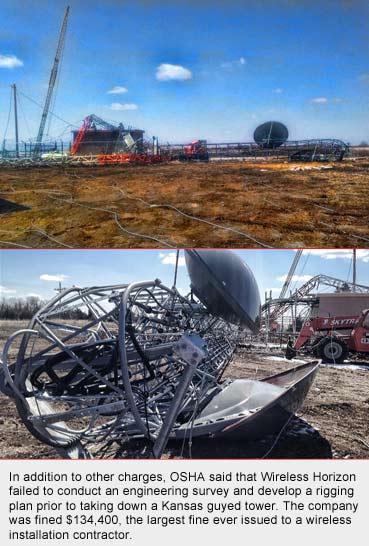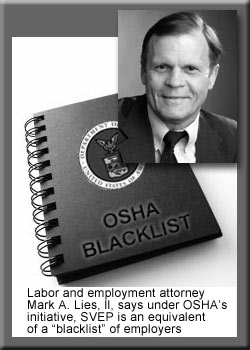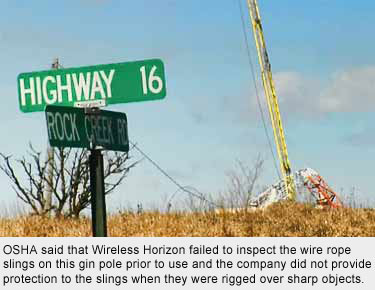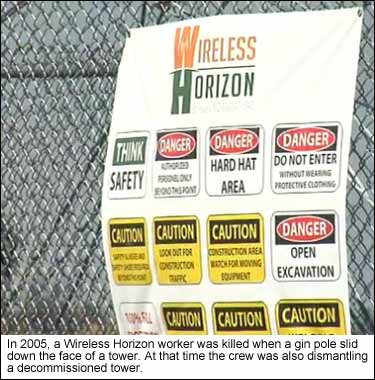|
Federal flogging of a Missouri tower contractor is OSHA’s warning that they’ve had enough
September 27, 2014 – In advance of a joint OSHA / FCC workshop on Oct. 14, 2014 in Washington, D.C. regarding tower climber safety and injury prevention, OSHA has delivered a public flogging and a $134,400 fine to a St. Peters, Mo. tower contractor following the death of two of its workers after two towers collapsed in Blaine, Kan.
 OSHA also placed the installation contractor, Wireless Horizon Inc., on the Severe Violator Enforcement Program (SVEP) following the incident as well as citing them for two willful and four serious safety violations. SVEP has been identified by a number of industry observers as being essentially a blacklist that could cripple a company’s revenue streams and put them out of business. OSHA also placed the installation contractor, Wireless Horizon Inc., on the Severe Violator Enforcement Program (SVEP) following the incident as well as citing them for two willful and four serious safety violations. SVEP has been identified by a number of industry observers as being essentially a blacklist that could cripple a company’s revenue streams and put them out of business.
"Two families have lost their loved ones in a preventable tragedy. No one should ever have to endure that loss. Inspecting and ensuring equipment is in good working order is a common-sense safety procedure that stops injuries and fatalities," said Dr. David Michaels, assistant secretary of labor for occupational safety and health in making the citations announcement that castigated the contractor.
"OSHA expects tower owners and operators, such as Wireless Horizon, to protect their workers on job sites in this hazardous industry by increasing training and implementing all known safety precautions. Our nation's growing need for telecommunications should not cost workers their lives."
Dr. Michaels has made it clear in recent statements that he is concerned about the high fatality rate within the wireless construction industry and will be attacking it on multiple fronts to reduce deaths.
Citing Wireless Horizon was a down-to-the-wire decision
OSHA Area Director Judy Freeman signed off on the citations and fines proposed by her investigators on Sept. 19, 2014 for the incident that occurred on March 25, 2014.
By law, had OSHA waited another six days they could not have charged the company with any violations since the agency is required to issue citations within six months of a violation’s occurrence.
 However, if OSHA is contemplating placing a company on the severe violator list, considerable investigation time and effort is necessary so that approval to move forward is obtained by the area solicitor and most likely the regional administrator who will want to establish a solid case since it will probably be challenged. However, if OSHA is contemplating placing a company on the severe violator list, considerable investigation time and effort is necessary so that approval to move forward is obtained by the area solicitor and most likely the regional administrator who will want to establish a solid case since it will probably be challenged.
They also know that it will get a critical review from Dr. Michaels.
Due to the severity of being identified as a SVEP company, which would have serious implications for obtaining future business for the cited contractor, approximately 44% of SVEP-related citations are contested, which is significantly higher than the national rate of 8%, according to an OSHA study.
"If an employer's citation history causes it to be identified as an employer classified as a severe violator under the SVEP, it will face significant OSHA scrutiny and, since the SVEP is equivalent to a 'blacklist' of the employer, it will cause the employer to be viewed very negatively throughout its industry and impact its ability to qualify for business opportunities," explained labor and employment attorney Mark A. Lies, ll to Wireless Estimator when the program was introduced in 2010.
Wireless Horizon is the first telecommunications contractor to be placed on the SVEP list which contains approximately 450 companies.
Wireless Horizon, founded in 2000 and owned by Larry Heisler, had approximately 60 employees at the time of the incident.
Gin pole failure killed both men
OSHA said that the tower technicians, ages 25 and 38, were using a gin pole attached to the side of the tower with a wire rope sling.  The sling failed, causing the gin pole to fall and bring the tower down with it. The sling failed, causing the gin pole to fall and bring the tower down with it.
One of the employees was above the gin pole near the top of the tower, and the second employee was approximately 20 feet below the pole. Both workers fell to the ground during the collapse. As the tower fell, it also struck an adjacent tower, causing it to collapse as well.
A spokesperson for Union Pacific Railroad, the guyed tower’s owner, had said following the incident that the two workers were very experienced. OSHA said that one of the employees had been with the company two months, while the other employee had only been working there for five months when the incident occurred. The deceased workers were on a four man crew.
OSHA's inspection found that the equipment the company provided the workers was in poor repair and the company did not use proper engineering plans to ensure their workers were protected against this type of collapse.
Fines could have been more
The agency’s investigation found that Wireless Horizon failed to inspect the wire rope slings prior to use and provide protection to the slings when rigged over sharp objects. These failures resulted in the issuance of two willful violations. A willful violation is one committed with intentional, knowing or voluntary disregard for the law's requirements, or with plain indifference to worker safety and health.
Wireless Horizon also failed to conduct an engineering survey and develop a rigging plan prior to beginning the demolition process. Additionally, the company did not provide the technicians a load chart for the gin pole in use or operator manuals, according to OSHA.
OSHA issued four serious citations for these violations. A serious violation occurs when there is substantial probability that death or serious physical harm could result from a hazard about which the employer knew or should have known.
Although OSHA could have fined the company $70,000 for each willful violation, the amount was reduced 20% to $56,000. The agency could have reduced it 30%, an allowable penalty calculation reduction for companies with 26 to 100 employees. The serious violations, allowable to be $7,000 each, were reduced to $5,600.
However, according to an April 22, 2010 memo from Dr. Michaels, area directors are allowed to increase penalties by 10% if the employer has been cited for a high-gravity serious, willful, repeat or failure-to-abate violation in the past five years.
The citations are available for viewing here.
OSHA said that Wireless Horizon had been inspected on two previous occasions since 2005, and was issued multiple serious violations both times.
Company was cited for another gin pole-related fatality
What triggered the company’s SVEP status is unclear, and agency officials cannot discuss the case until such time as it is completed. One repeat citation in the context of a fatality or catastrophe can cause SVEP status, but the citation must have occurred within the previous five years.
 Although OSHA’s establishment search database indicates that there was an event that occurred on Jan. 1, 2013, no details are provided. Although OSHA’s establishment search database indicates that there was an event that occurred on Jan. 1, 2013, no details are provided.
On June 6, 2005 Wireless Horizon was cited with a serious violation when an employee was killed after he climbed down a gin pole to attach a sling to a tower section that was going to be removed, according to OSHA.
The gin pole on the Lincoln, Ill. microwave tower then began sliding down the tower face and it was abruptly stopped by the load line’s ball, causing the climber to fall approximately 120 feet to the ground.
The 43-year-old Arizona tower tech had previously worked for Wireless Horizon and had returned to the tower erection firm just six days before he fell. He was working on a Verizon tower that was being decommissioned.
In an informal settlement, OSHA reduced Wireless Horizon’s fine down to $750 from the issued $1,500.
Fine is highest ever issued in the industry
OSHA’s Wireless Horizon fine of $134,000 is the largest amount that has ever been levied against a wireless installation contractor since Wireless Estimator began tracking industry fatalities in 2003.
The second highest amount was issued to Viaero Wireless in the amount of $125,000 following the death of a tower tech in Yuma, Colo. in 2005. The company agreed to the fines in a formal settlement.
OSHA said that Viaero's tech was suspended using his work-positioning lanyard from an antenna mount when he fell. It was identifed that the snaphook on his fall-positioning lanyard had been previously damaged and he was not tied off with his fall arrest lanyard.
The third highest fine was issued to Electronics Research, Inc. in 2011.
Following the death of two of the company’s employees when a gin pole broke loose from faulty rigging on a jobsite in Ind., the company received a $91,500 fine. However, it was later reduced by IOSHA to $18,000.
As part of the settlement, ERI agreed to "conduct training regarding proper rigging and operation of gin poles for tower erection and Respondent shall offer such training to other persons and contractors in the industry on a 'fee for training basis'."
The agreement was troubling to two industry executives knowledgeable about the proceedings who thought that IOSHA didn’t have to “cave in” to their solicitor’s belief that they might lose the case if it was brought before an administrative law judge.
 Wireless Horizon has 15 business days from receipt of the citations to comply; request an informal conference with OSHA's area director in Wichita, Kan., or contest the findings before the independent Occupational Safety & Health Review Commission. Wireless Horizon has 15 business days from receipt of the citations to comply; request an informal conference with OSHA's area director in Wichita, Kan., or contest the findings before the independent Occupational Safety & Health Review Commission.
If Wireless Horizon contests the citations and they are not vacated, after a period of three years following the final appeals decision, the contractor can ask to be removed from the SVEP list if they’ve abated all hazards, paid all penalties, abided by all settlement provisions, and have not received any similar serious citations during that period.
A follow-up inspection is required to be conducted in every SVEP case after citations become final orders in order to assess whether the cited employer continues to commit similar violations.
Upon attempting the follow-up inspection, OSHA found that a significant number of employers had gone out of business or the worksite had been closed.
|